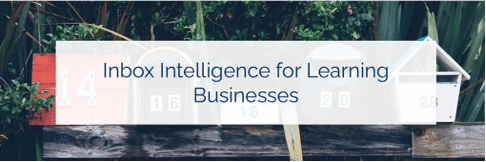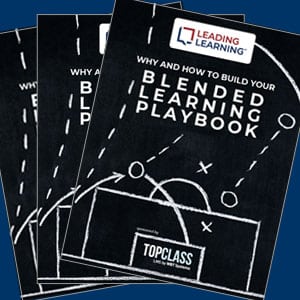When we said goodbye to 2022, we took time to reflect on milestones, trends, and potential implications for learning businesses in the previous episode. Now it’s time to prepare for the new year and look ahead to the areas that are likely to impact learning businesses most in 2023.
In this first episode of the new year, we share data from a recent survey to uncover the top areas of focus for learning businesses in the coming year. We also share our key takeaways from the data and the related implications for the learning business landscape.
To tune in, listen below. To make sure you catch all future episodes, be sure to subscribe via RSS, Apple Podcasts, Spotify, Stitcher Radio, iHeartRadio, PodBean, or any podcatcher service you may use (e.g., Overcast). And, if you like the podcast, be sure to give it a tweet.
Listen to the Show
Access the Transcript
Download a PDF transcript of this episode’s audio.
Read the Show Notes
[00:00] – Intro
Areas of Focus for Learning Businesses in 2023
[01:05] – To help us look at the year ahead we draw on data we collected via an online survey in October and November 2022. We received qualifying responses from 155 learning businesses of all types. Respondents included charitable or philanthropic organizations, educational institutions, for-profit businesses, and associations (the largest segment of respondents, about 41 percent).
We asked survey respondents which of 15 areas of activities they’re already pursuing, planning to pursue in 2023, or not planning to pursue.
- Creation of learning experiences that combine online elements with face-to-face elements
- Implementation of technologies that leverage artificial intelligence to support or enhance learning
- Microlearning opportunities
- Providing a personalized learning experience
- Creation of social, peer-to-peer, or cohort-based learning experiences
- Use of virtual reality or augmented reality to provide new learning experiences or enhance existing experiences
- Use of blockchain as an approach to managing records related to learning or certification/credentialing
- Use of virtual conferences (and we defined a virtual conference as an online event similar to a traditional face-to-face conference, not just a single Webinar)
- New or alternative approaches to credentialing, including certificate programs, microcredentials, and digital badges
- Aligning offerings with specific career or job paths relevant to learners—e.g., through a competency model, learning pathways, or targeted curricula
- Integration of educational offerings into the learning and development programs of employers in a field or industry or into general workforce development needs
- Development of strategies or tactics to help combat declining enrollments, downward price pressure, or “commoditization” of educational offerings
- Increased efforts to gather and analyze data to inform new product decisions or improve existing products
- Increased efforts to gather and analyze data that demonstrates the impact or effectiveness of the learning experiences offered
- Implementation of methods to ensure that learning is retained and applied over time
We asked about these areas in an end-of-year survey we ran in 2020 and 2021, and we developed the original list in 2018. To develop the list, we used a modified crowdsourcing approach, soliciting the insights of those working in and with learning businesses, and then we folded in our own observations and thoughts to arrive at the list of 15.
We recommend you take a moment to think about your own priorities and which of these 15 areas, if any, you’re likely to act on in the coming year.
And, in addition to asking yourself about your priorities, also ask if your priorities are clear throughout your learning business? Is everyone on the team aware of and crystal-clear on your priorities for the year ahead?
Celisa Steele
Leading Learning Newsletter
[06:01] – As someone who listens to the Leading Learning Podcast, you should know about the Leading Learning newsletter.
The newsletter is inbox intelligence for learning businesses and helps you understand the latest technology, marketing, and learning trends and grow your learning business. Best of all, it’s a free resource. As a subscriber, you’ll get Leading Links, our monthly curated collection of resources to help you grow the reach, revenue, and impact of your learning business; the podcast digest, a monthly summary of podcast episodes released during the previous month; plus periodic announcements highlighting Leading Learning Webinars and other educational opportunities designed to benefit learning business professionals.
Subscribe for free. Or, if you’re already subscribed, point a colleague to leadinglearning.com/inbox.
Top Areas of Focus for Learning Businesses in the Coming Year
[07:02] – Here are the top six areas either being pursued or planning to be pursued in 2023.
- Increased efforts to gather and analyze data to inform new product decisions or improve existing products (93 percent).
- Increased efforts to gather and analyze data that demonstrates the impact or effectiveness of the learning experiences we offer (89 percent). This area came in seventh last year.
- Creation of learning experiences that combine online elements with face-to-face elements (82 percent). The focus on this area isn’t surprising given we’re emerging from the COVID and gathering face-to-face again seems reasonable. During the pandemic, learners also saw firsthand the convenience and effectiveness of online learning, so combining online and face-to-face seems natural.
- Providing a personalized learning experience (82 percent). Personalization has long been a Holy Grail of learning, and adult learners seem increasingly intolerant of experiences that waste their time and money by covering ground they already know.
- Creation of social, peer-to-peer, or cohort-based learning experiences (79 percent). This area fits with the hunger for social connection that the pandemic deepened.
- Microlearning opportunities (79 percent). Microlearning respects learners’ time, and, because of its tight focus, it can allow learners to pick relevant topics and skip irrelevant ones.
The top two areas overall—data for product decisions and data to show impact—are also areas where more than half of respondents plan to begin work in 2023. The other top six areas have larger segments already doing the work. The two data areas represent the highest new activity among respondents.
But, obviously, data has been a buzz area for years now, data and analytics, particularly around being able to demonstrate impact. But we know from our experience that, in a lot of cases, learning is being put out there without really any thoughtful, intentional way of measuring impact, getting the data that shows that we actually move the dial with the learning experiences.
Jeff Cobb
Data should also inform how products are designed and which products are offered in the first place. Often a committee or just a few people will create a product, and it’s a shot in the dark because there isn’t broader data informing the product decisions.
In these top areas, there’s an emphasis on rich data that can provide insight and help determine future direction and a focus on data that gives you a fuller picture of what the market needs and a better understanding of how learners are responding and interacting with your offerings.
Three Takeaways and Implications for the Year Ahead
[11:44] – Based on the survey data and our own observations, we’ll offer three takeaways and some implications of each.
Innovation at the Edges
For the foreseeable future, product innovation for learning businesses is likely to be more about meaningful but incremental changes to well-established models than about bold leaps or blue oceans.
The range of what most learning businesses offer has been the same for quite some time. The shift online was a disruptor once upon a time, but, even before COVID, online learning was an established fact.
So the question is: How do you get better at what you’re already offering and generate more value?
Trying to answer that question may explain the focus we see in the survey results on data to inform product decisions. We need data to know where and how we can make meaningful changes that meet learner, employer, and other stakeholder needs.
The interest in social and cohort-based learning is arguably also evidence of a shift toward innovation at the edges. These are hardly new approaches, but figuring out how to do them better and showing the impact may give a learning business the edge it needs in its market.
The economy is also a factor in this takeaway.
In shaky, uncertain economic times, there is often less of an appetite for bold moves, and there’s more of a desire to make what we have work. And there’s this pressure to make sure that any new initiatives, that we get those right the first time. And, again, that brings us back to having the data necessary to make well-informed decisions.
Celisa Steele
Because innovation at the edges is likely to be highly data-dependent, it’s worth nothing that it’s harder and harder to get prospects and existing customers and learners to provide data through traditional means like surveys (something we touched on in episode 335). Identifying baked-in ways to collect data will be increasingly important—as will be making good use of that data as the basis for small innovations.
Blended Learning’s Rebirth
[15:44] – We’re betting on a renewed interest in and use of blended learning in 2023 and beyond.
Our definition of “blended learning” draws on the work of the Christensen Institute and its Blended Learning Universe, which describes blended learning as a formal education program which meets three criteria:
- Students learn in part through online learning, with some element of student control over time, place, path, and/or pace.
- Students learn in part in a brick-and-mortar location, where instruction is facilitated.
- The online and offline modalities are connected to provide an integrated learning experience.
This takeaway about blended learning is supported by two of the top six areas we saw in the survey data: combining online and face-to-face elements in learning experiences and social, peer-to-peer, and cohort-based learning experiences.
The in-person component of blended learning fits well with the pent-up hunger for social connection that’s come from the pandemic.
The online piece speaks to learner convenience and the ability to have more flexibility about when and/or where to learn—a convenience that many people got used to during the pandemic and work-from-home situations. The online piece also helps lessen the environmental impact of in-person learning that requires travel, and we think there will be increasing scrutiny of the environmental impact of learning.
Each mode has advantages on its own, and combining in-person and online creates the opportunity for greater effectiveness than either mode alone and leverages the compelling, appealing benefits of each mode.
For a deeper discussion of the benefits of blended learning, we recommend our executive briefing “Why and How to Build Your Blended Learning Playbook.”
And check out our related episode about blended learning, “The New Blended Learning.”
Blended learning can help create loyal customers, learners, and members, and that speaks to that dwindling trust issue we raised in episode 335. As humans, we tend to trust and like people we’re in relationships with, and blended learning puts learners in relationships with each other, and the learning business, as the organizer, will benefit from the trust created in those relationships as well.
Business (Re)models
[18:51] – We put the R-E in parentheses, so this can be read as “business models” or “business remodels.”
Organizations that may not have ever had to give too much thought to their business model will need to start. And even those that have given a lot of thought to their business models may have some rethinking to do. They may need to remodel those business models.
Jeff Cobb
In an uncertain economy and in times of high inflation, spending can be tight, which impacts what individuals and organizations are able and willing to spend on learning.
The good news is that currently in the U.S. we have a lot of job vacancies, so reskilling, upskilling, and onboarding are needed even more now (we touched on this in episode 335).
All of this points to the need to find those small innovations that increase the real and perceived value of our offerings and to the need to find new and improved approaches for generating revenue from those offerings.
Part of the attraction of approaches like blended learning, cohort-based learning, and microlearning is that they may provide ways to create monetizable add-ons to or variations or extensions of traditional offerings like conferences or seminars, which can change what and how we charge for those offerings.
Microlearning, for example, can make sense as part of a subscription or membership model. We believe we’ll see more offerings where education is sold not as single event or unit of content but as a part of a fuller pathway or journey.
One of the areas we asked about in the survey that just missed being in the top six was around aligning offerings with specific career or job paths relevant to learners—just under 75 percent of respondents said they are already doing that or plan to pursue starting in 2023.
We also anticipate more learning businesses that sell primarily to individuals evolve into selling business-to-business or finding new ways to distribute their offerings through partners.
All this suggests more sophisticated models than the traditional fee-for-registration model, and these models will require greater business development acumen.
Reflection Questions
[22:45] – Reflect individually and with your team.
- Which of our three takeaways—innovation at the edges, blended learning’s rebirth, and business (re)models—resonates the most with you?
- What takeaway might you add from the data we shared and/or your own observations of the learning landscape?
[23:19] – Wrap-up
To make sure you don’t miss new episodes, we encourage you to subscribe via RSS, Apple Podcasts, Spotify, Stitcher Radio, iHeartRadio, PodBean, or any podcatcher service you may use (e.g., Overcast). Subscribing also gives us some data on the impact of this particular part of our content strategy.
We’d also be grateful if you would take a minute to rate us on Apple Podcasts at https://www.leadinglearning.com/apple or wherever you listen. We personally appreciate reviews and ratings, and they help us show up when people search for content on leading a learning business.
Finally, consider following us and sharing the good word about Leading Learning. You can find us on Twitter, Facebook, and LinkedIn.
Episodes on Related Topics:




 Redux: The Surprising Truth About Human Behaviors and Learning with Dan Pink
Redux: The Surprising Truth About Human Behaviors and Learning with Dan Pink
Leave a Reply